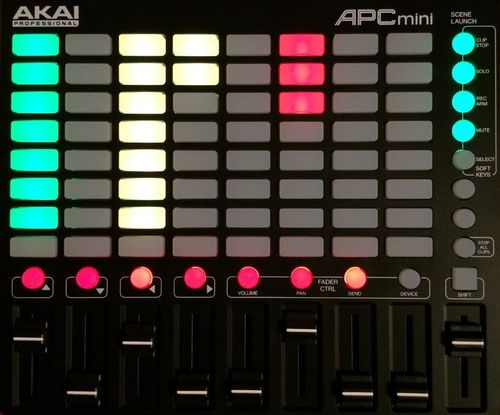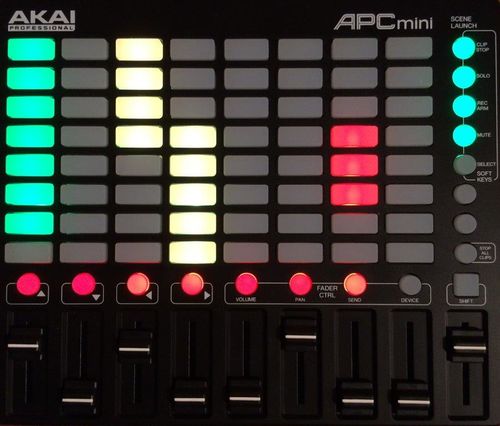Akai APC Mini
The Akai APC Mini is well suited for use as a Midi controller for Box Of Stops.
The large grid of 64 buttons can respond in Green, Yellow and Red, to show the different banks in Box Of Stops. And the nine sliders at the bottom can be assigned as volume controls for the banks and master volume. For example, the ability to balance pedals is surprisingly useful.
Box Of Stops comes with built-in support for the APC Mini. This means:
- It can turn on the lights on the device, to show where stops, couplers or combinations are
- Start the lights flashing to show which controls are playing
- Automatically arrange the Registration across the APC Mini, to match the layout shown in a web browser
Here the APC Mini is showing a registration with three banks. The Great is shown in Green, the Swell in Yellow and Pedal in Red. Then the combinations are the Green buttons on the right and the couplers are in Red below the grid.
Contents
[hide]Plugging in
When the APC Mini is first plugged in, Box Of Stops will:
- Exchange a Sysex Device Inquiry message, to detect the APC
- Play a short animated light show as a welcome - video here
- Arrange the current Registration across the buttons and sliders of the APC
It is now ready to use, with no further configuration.
Auto arrange
Whenever a Registration is selected or changed in Box Of Stops, this is automatically shown on the APC in an arrangement very similar to that seen from a browser:
- Each bank is assigned a column of buttons on the main 8x8 grid
- Then the combinations are shown down the round buttons on the right hand side. (These buttons on the APC can only show Green)
- And the couplers are shown across the round buttons under the main grid. (Again, these buttons on the APC can only show Red)
- The sliders at the bottom are assigned to the bank volume for the bank on the same column above in the 8x8 grid
- The last slider on the right is the Master volume
- The Shift key (on the bottom right corner) is not used by the auto-arrange, as it has no light behind it. If you choose, it can still be assigned as a Trigger, it just won't be able to show its current state
Using
To play any stop, coupler or combination in Box Of Stops, just press the corresponding button on the APC. That button will respond by starting to flash. Press the button again to cancel the control.
Note all the controls are linked up. E.g. if you press a button in the browser, or a Gpio button, the equivalent button on the APC will change state too. It makes no difference which controls you use.
Please pay no attention to the labels around the buttons on the APC. Instead Box Of Stops uses a simple layout of the registration controls, as described above.
A common approach to using Box Of Stops is to use the APC Mini as the primary control when playing the organ, but to keep a tablet device, or a smartphone, near by. This can then be used to confirm the order of the stops, or to tweak the configuration for a particular piece.
Steering the auto-arrange
If you want to move things around on the APC, the system is actually the same as learning any other trigger:
- First use Configuration mode to add a trigger to any Stop, Coupler or Combination
- Press the button you want to assign on the APC
- Once you OK the screen, you will see the selected button light up, to show the control in its new position
When you move a stop in a Bank, or move a coupler or a combination, this automatically takes any remaining controls in that list with it. This is called Anchoring, and enables you to move a whole bank at a go, or split a bank in the middle, without having to move all the controls.
If you want to undo an Anchor, open the properties window for that control, and delete the Trigger that you added earlier. That control, and any after it, will move back to where the Auto arrange had put them before.
Here the fifth stop on the Swell (in Yellow) has been moved and also the first Pedal stop (in Red). The remaining stops automatically line up after the one that has been moved.
Timeout
After 10 minutes of inactivity, Box Of Stops will automatically timeout the lights on the APC.
It will wake up again when activity is next detected. This could be anything, e.g. a button on the APC, or a note being pressed on a keyboard.
If you wish to change the 10 minute default, please look for the midi.timeout.minutes value in Application properties.
Other controllers
For a cheaper Midi controller that also offers feedback lights, and sliders, please see the details about the Korg nanoKONTROL2.
At a much simpler level, there is also the option of using the Status Board from The Pi Hut. This plugs directly into the Gpio connector on the Raspberry Pi.

